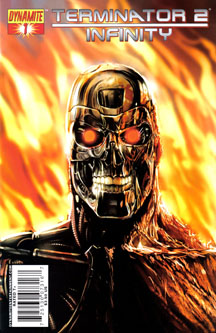While not exactly a failure, the “Terminator 3” franchise petered out fairly quickly compared to other “Terminator” multimedia campaigns, with the last novel coming out in 2004. Three years later, the saga was resurrected, although new license-holder Dynamite Comics (acquiring the “T2” license previously held by Malibu Comics) opted to play in the original “T1”/”T2″ timeline rather than pick up on the “T3” threads left dangling by Aaron Allston’s books. It’s likely Dynamite also acquired “T3” licensing rights (previously held by Beckett), as it incorporates elements from that movie as well.
Written by Simon Furman with art by Nigel Raynor, the five-issue “Terminator 2: Infinity” (2007) is a heretofore unexplored “T2” timeline that has elements of “T3.” But it clearly is not on the “T3” timeline for a variety of reasons that I’ll explain below. Furman’s main goal is to explore John Connor’s rise to Resistance leader. It may seem inevitable in the movies – and novels such as S.M. Stirling’s and Russell Blackford’s give detailed accounts of John’s journey to leadership — but “Infinity” imagines a case where John resists taking up the mantle.
CHARACTERS
John Connor: Somewhat minimizing the importance of John’s Campbellian hero’s journey in “T2” and “T3,” he reverts to full-on “Why me?” whiny mode in this story. He has the usual complaints about how everyone he cares about dies. But after surviving a near-suicidal mission, and being motivated by a pep talk from Tara Holden, he decides he’ll lead the Resistance after all; essentially, he’s a late bloomer. Having been born in 1984 – as per the original “T1″/”T2” timeline — John is 25 in 2009.
Sarah Connor: She’s not in this story, having died between the events of “T2” and “T3.”
Kyle Reese: A young boy named Kyle (almost certainly Kyle Reese) is hanging out with John’s Resistance troupe in 2009, but he doesn’t play a major role in the story.
Kate Brewster: She had died in 2007, at age 22 (having been born in 1985), in this continuity. John loved her, although the exact details of their relationship have to be slightly different than what we saw in “T3,” as they were four years older on that timeline than on the Dynamite timeline.
Tara Holden: A former U.S. military woman, she now leads a Resistance troupe. She responds to John’s Morse code message for Resistance groups to meet up and join forces, and becomes a second-in-command to John. The last panel reveals that she will be John’s wife, Tara Connor, by 2015. Tara is the second example of John having a wife/second-in-command in “Terminator” lore, following Kate Brewster of the “T3” saga, although he also had a significant other in Juanita Salceda in the Blackford trilogy.
TERMINATORS
Uncle Bob: Despite sharing the nickname, he’s not the 1995 “T2” unit, or even the same model. But he is a good Terminator sent back from 2030-something by John to protect John in 2009 and see that he fulfills his destiny. Presumably a T-800, Uncle Bob is unit number 675/45.

T-Infinity: This “temporal Terminator” is sent back from 2033 by Skynet with the aim of fixing “primary sources of corruption in the timestream” because “the timeline (has been) damaged” by those sources. One of those sources is the Uncle Bob of this story. The T-Infinity doesn’t need a Continuum Transporter (a.k.a. time displacement equipment, a.k.a. time vault) to move through time. Rather, it can phase itself (“temporal relocation”) to different places, similar to “X-Men’s” Nightcrawler – a handy battlefield tactic. Even more impressively, it can phase itself to different points in time; essentially it is a Terminator with a built-in Continuum Transporter.
Endoskeletons: The standard battlefield unit.
CONTINUITY AND CONTRADICTIONS
“Infinity” takes place in 2009 on a new timeline that springs from “T2” and also incorporates the broad elements of “T3,” namely the fact that J-Day occurred in 2004. But this story branches from the “T2” timeline, not the “T3” timeline, as I’ll explain in the Timelines and Time Travel section.
We’re told the events of “T2” happened in 1995. This is consistent with the film, the novelization, the Malibu Comics and the Stirling trilogy, but different from the Blackford/Tiedemann novels – the most recent “T2” timeline we had seen — in which the “T2” events happened in 1994.
The Resistance is on the verge of winning the war in 2033 in the opening panel of “Infinity.” This is why Skynet sends the T-Infinity on its mission. In the original “T1″/”T2” timeline, the Resistance is on the verge of winning in 2029, hence the time-travel missions of those movies. But the war continues beyond 2029 in numerous timelines, including that of the Now Comics, which didn’t explain why the war continued; the Malibu Comics, which ended with a cliffhanger where Skynet turns the tide of the war in 2029; and the “T3” franchise, which downplayed the idea of a pivotal 2029 victory by the Resistance.
Uncle Bob greets John with “Come with me if you want to live,” which is of course a nod to the first two “Terminator” films. “T3” wisely resisted using it, instead going with “You wanna live? Come on!” The increasingly tired line would also pop up again in “The Sarah Connor Chronicles,” “Terminator Salvation” and “Terminator Genisys” — and probably other comics and novels, too.
Skynet controls the radio waves in this story. John’s mission is to send out Morse code on a back channel – hoping Skynet won’t notice it – in order to bring scattered Resistance cells together. In other timelines, the Resistance had found airwaves that Skynet ignored due to Resistance programming (Allston’s “T3” novels) or piggybacked on Skynet signals in a way that Skynet didn’t notice it (the Stirling trilogy).
The idea of bringing Resistance cells together contrasts with the Resistance’s usual strategy of keeping cells separate for the sake of safety. However, this is early in the war, where the Resistance structure has not been organized yet. John needs to bring everyone together in order to set up that structure in the first place.
Albuquerque, N.M., is the location from which John can send out the Morse code signal. John and Sarah Connor called Santa Fe, N.M., home in the opening chapters of Mark Tiedemann’s novel, “Hour of the Wolf.”
In the 2009 of this timeline, the human fighters are only familiar with the endoskeleton models, not infiltrator models, meaning Skynet has not built T-800s – or even T-600s — yet. This is consistent with the original “T1″/”T2” timeline, where T-800s were new in 2029. It contrasts with the “T3” timeline, where T-800s were already on the drawing board before Judgment Day. Interestingly, 2009 is the precise year that T-800s roll off the assembly line in the Dark Horse “T1” 1984 saga.
Denver is where Skynet is mass producing its weaponry. While Colorado is almost always the headquarters of Skynet, Cheyenne Mountain is usually the specific location.
Skynet also has a major hub in Nebraska, out of which the T-Infinity operates. It’s the first time the Cornhusker State has factored into “Terminator” mythology.
“Infinity” ends on a cliffhanger where the T-Infinity announces its next mission is to go after Tara (Holden) Connor in 2015. That story will be told in “Revolution” (2009).
TIMELINES AND TIME TRAVEL
“Terminator 2: Infinity” is set in 2009 on a new Dynamite Comics timeline springing from “T2.” On this timeline, “T1” happened in 1994, “T2” in 1995 and the broad events of “T3” in 2004. This is different from the “T3” timeline, where “T1” happened in 1980. In addition to John being a different age, other details of “T3” are contradicted in “Infinity,” such as the fact that Infiltrators haven’t been invented yet. As such, it makes sense to say the Dynamite timeline is a “T2” timeline (and, of course, the title confirms this) with elements of “T3.” In the “T3” franchise, “T3” is the anchor story and the broad elements of “T1” and “T2” are in its backstory.
While the Dynamite timeline is a “T2” timeline, we know it is a different “T2” timeline from the Stirling trilogy and the Blackford/Tiedemann books. Those timelines had gone off in different directions by 2009. While “Infinity” could theoretically fit into the Malibu Comics timeline, which largely jumped from the present (“Cybernetic Dawn”) to the future (“Nuclear Twilight”), there are so many major elements that don’t cross over that it seems certain this is a new timeline. For example, John’s wife Tara is not mentioned in the Malibu Comics, and John’s best bud Danny Dyson is not mentioned in the Dynamite Comics.
Since the aforementioned “T2” timelines all branched off from the main timeline thanks to the emergence of a time traveler, it’s possible that the Dynamite timeline is the original, or base, “T2” timeline – one in which the major events of “T3” follow. Those iconic events include the 2004 J-Day, Kate Brewster being introduced as John’s love interest and a T-850 being sent back as a protector. I give these events “iconic” or “anchored” status simply because they carry across multiple timelines. Dynamite’s original (pre-time traveler) timeline continues up until the Resistance’s near-victory in 2033, which does not include Kate, as she had died in 2007. Then a branch occurs when the Uncle Bob and T-Infinity units appear in this 2009 where Kate had died in 2007 and John is moping around. Why Future John felt he had to send Uncle Bob to 2009 is unclear. Perhaps, looking back on things from a place of success, he was disgusted with his younger self and wanted to accelerate his rise to Resistance leader. Or maybe it’s like the parody trailer of “Terminator Genisys” and John had simply lost his mind and sent gaggles of Terminators back through time.
On the final page, the T-Infinity says it has terminated “two of the four primary sources of corruption to the timestream,” and oddly, we see a panel of it terminating the T-X from “T3” rather than the T-850 from “T3.” Perhaps this was a way for the authors to say they didn’t like “T3” or the T-X and they were “terminating” it from this timeline. Or perhaps in the Dynamite timeline’s equivalent of “T3,” the T-X was actually the protector. Allston’s “Terminator Hunt” ended with a T-X on the side of the good guys, so maybe it was a nod to that story.
The T-Infinity doesn’t need a Continuum Transporter (a.k.a. time displacement equipment, a.k.a. time vault) to move through time. Rather, it can phase itself (“temporal relocation”) to different places, similar to “X-Men’s” Nightcrawler – a handy battlefield tactic. Even more impressively, it can phase itself to different points in time; essentially it is a Terminator with a built-in Continuum Transporter.
Since the T-Infinity uses phrases such as “primary sources of corruption in the timestream” and “the timeline is damaged,” it seems like “Infinity” subscribes to the theory of a single – but changeable – timeline. The T-Infinity is aware of what the “correct” timeline should be and works to bring that about. However, it seems like the humans are not privy to the idea of a timeline that changes, nor would they be aware of such changes if they did happen; each human is living his or her own life on the one timeline he or she calls home.
Of course, we as readers are aware that there are multiple branching timelines in “Terminator” lore. But that doesn’t necessarily negate the importance of the T-Infinity “fixing” this timeline, which – from its perspective – is the only one that counts. While the Blackford trilogy had people and robots hopping across timelines via the time vault, that seems to be beyond the ability of the T-Infinity.

